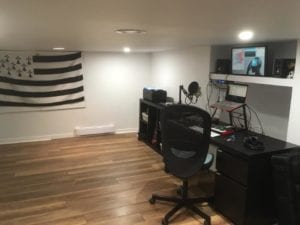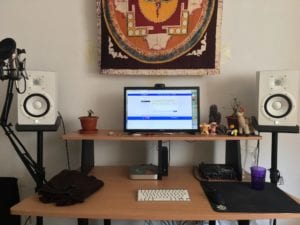Setting up your studio and understanding acoustics can be a bit overwhelming, until now.
Gravitas Create recently had the pleasure of setting up a Q&A session in our FB Community Group with James Lindenschmidt of GIK Acoustics. This allowed the members to freely ask questions about proper studio acoustics. We sorted through the thread to provide you some great nuggets of information. If you want to dig through the original session, CLICK HERE.
PSYMBIONIC: My question is about a computer screen and positioning between my speakers. I’ve heard that anything that sits between your speakers can affect stereo image. Right now, my speakers have ended up at about a 4ft equilateral triangle with my listening position, and my computer screen sits 2-3″ behind the inside angle in between the speakers. As long as my screen sits behind my speakers, that shouldn’t affect the stereo image at all right?
GIK ACOUSTICS: No problem, happy to be here! Regarding the monitor and the screen the best answer is to experiment. The further back the better, but sometimes ergonomically the monitor has to be forward of the line between the speakers. As long as the monitor isn’t blocking the sound from the speakers, or aiming reflections toward your ears, then you will probably be OK. Again, experimentation is key…. listen for irregularities between, say, 400Hz and 1K for this stuff. In the old days we worried about reflections from the console as well, that falls into this same category.
GARRETT MOHR: Is there such a thing as having too much treatment?
GIK ACOUSTICS: Yes and no. It’s very easy and common to have too much high frequency absorption. On the other hand, you can’t really have too much bass trapping. There is a point of diminishing returns there, but the more you add the better the bass response will get. Keep in mind, high end purpose-built control rooms often have “false walls” visible on the inner shell, that conceal absorption often several feet thick to really help the low end. While you don’t need to go to that extreme to make great improvements, that illustrates the point. It’s really common to have too much high end absorption, and not enough bass trapping (you see this mostly when people hang blankets or thin foam wedge sheets all over their rooms), which results in a kind of unpleasant dead, boomy sound. To combat this, you want a balanced approach. Plenty of bass trapping, literally as much as you can fit into the room and the budget. Selective use of high frequency absorption at reflection points. And diffusion pretty much everywhere else. I wrote about achieving such balance here in this blog entry. Click HERE to read more.
JESSE BREDE: What’s the single most effective thing a producer can do to treat their room on a budget?
GIK ACOUSTICS: Set the room up well, and get as much treatment as you can fit into the budget. We have some room kits that are both affordable and allow you to address the most important treatment strategies. They are a great place to start. Click HERE for more info on Room Kits. Click HERE for more info on basics of a room setup. In most rooms I’d say 2-4 bass traps for the corners (more is better), and then absorbers (as thick as possible) at the reflection points on the side walls and ceiling. These address the 2 most important problems in small rooms, but as far as which is more important it depends on what’s bugging you the most. Bass trapping will even out the entire room, reduce the loud bass notes and bring up the quiet bass notes by reducing the interference that reflected bass waves do to one another. It will tighten the low end up, make it much more accurate, and consistent from note to note. The more bass traps you add, the better it gets. Click HERE for more info on Room Kits. Click HERE for more info on basics of a room setup. Click HERE for more info on Bass Traps.
GARRETT MOHR: What about floor treatment? For those that have wood floors is it best to put down rugs/carpet? Does it matter?
GIK ACOUSTICS: Doesn’t matter much. Wood floors are easier to clean and have wheeled chairs on. On the other hand, if you have a big wood floor between you and the speakers creating reflections, then sure put down a throw rug. Most people can’t put acoustic panels on the floor, though I have had a few customers with dedicated audiophile listening rooms do so.
MICHAEL ALFRED WAGNER: First, thanks for doing this. About to get some material to build diy panels in my workspace, so this is perfect. Couple questions. The space is a largeish room, with the ceiling slanted down all the way to the floor on the back side, and about 3/4 down to the front wall, meaning front and back walls aren’t vertical, but rather an irregular pyramid shape. How would this change how you treat the room? planning to focus on front wall behind the speakers, the front corners (only for about the meter up that its vertical), first reflection points, and back wall (though these panel will be slanted, does that matter?) -Also, using material roughly equivalent to 703s, is 4 inches deep plus an air pocket behind thick enough to have a fairly even frequency absorption? Is it worth going 8 inches deep on the front wall corner portions I’ll be able to cover?
GIK ACOUSTICS: 4″ is a good minimum thickness and should perform to under 100Hz. thicker is better if you have enough material. In unusually shaped rooms, this listening test is useful to find the bass buildups. check all the corners and the slanted surfaces, and any area with a bass buildup should get bass traps as thick as possible.
GUILLAUME NICODÈME: Hey James, any tips for acoustic treatment on a basement? With low ceiling? Thanks!

GIK ACOUSTICS: Yes, getting the speakers placed and the listening position placed are both important for accurate results. You want to pay attention both to the imaging as well as bass accuracy. Usually I like to put the speakers in an equilateral triangle with my head, or slightly behind my head, with the speakers on their own stands as close to the front wall as possible to avoid SBIR issues. Also, if you are in an unfinished basement and just need it to sound good and not stop sound from going upstairs, you could do worse than stuffing the space between the ceiling joists with thick insulation (R30 fiberglass minimum), and then covering the underside of the joists with cloth.
GUILLAUME NICODÈME: Thank you very much! Anything for the door itself? I have stairs going up and it seems that sound is almost only going upstairs from the stairs and thin door. Thank you!
GIK ACOUSTICS: Well, for treating the room, doors don’t present an inherent problem, unless they prevent you from putting a panel where it belongs (such as at a reflection point or in a corner for bass trapping). If you can, arrange the room so the setup puts the door away from these places. Also, stopping sound from entering or leaving a room is a very different problem from making the room sound good inside. Stopping sound will always involve some sort of construction, for doors you can add mass to the doors, improve the airtightness of the closed door, etc.
JACOB TW: I have a question about my own space and the diffusion/absorption i should place behind the desk/speakers: do I need to place them between the entire length between the monitors like what Richard Devine has done (if you google vikoustic richard devine diffusors) or is it fine to just put two panels directly behind the desk in the middle?

GIK ACOUSTICS: The front wall behind the speakers is generally the least important wall to treat. You can benefit from bass trapping directly behind the speakers, and if you have the reflection points and the rear wall behind you well treated, you can then treat the front wall appropriately (with absorption if the room is still too live, diffusion if it needs to be livened up some, or a mixture of both).
JACOB TW: Thank you! So far my teacher has said diffusion in front, behind on the back wall, and in the ceiling reflection points with a good rug beneath me. If you think I can get away with skipping the front wall, that will make my panels stretch a bit for now until I can afford more and I’ll just treat the sides back and ceiling.
GIK ACOUSTICS: I prefer absorption at reflection points…. in all the subjective listening tests, and objective measurements, absorption seems to always win. I think it’s because diffusors have a limited bandwidth relative to absorption (unless they are maybe several feet thick), so absorption works over the entire frequency spectrum. You can also combine absorption and diffusion in one panel, like this: CLICK HERE. But, others prefer absorption. There are differing opinions on this. For me, reflection points are pretty much the ONLY place where I want full on high frequency absorption (as thick as possible so it also absorbs bass). Pretty much everywhere else in the room should incorporate diffusion into the panel as well, in my opinion.
If you want to get in contact with James Lindenschmidt for further questions you can email him at [email protected]. You can also visit their website for more information as well.

Sorry, but you have already liked this article.